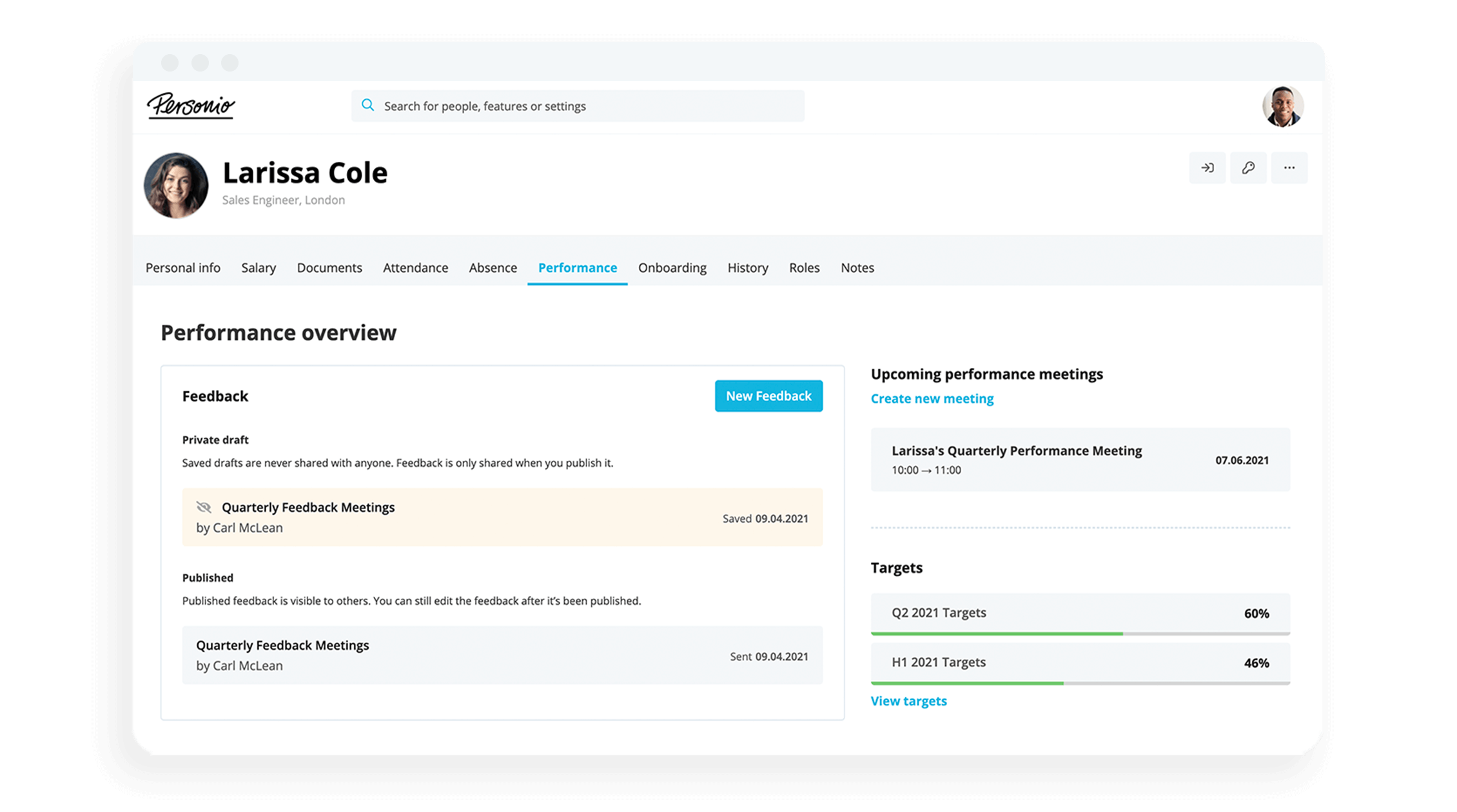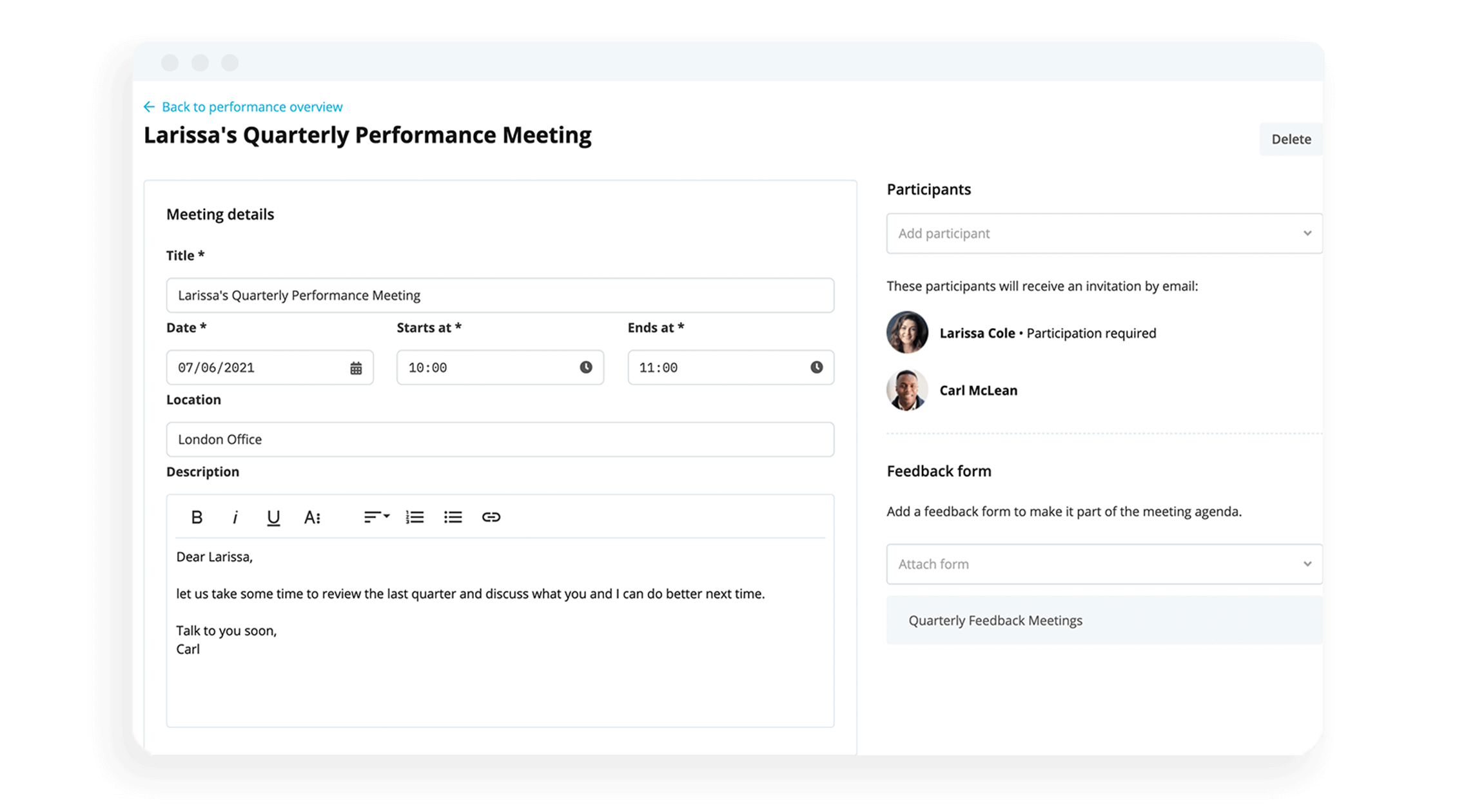1. July 2019
Best Practice: How We Created the Personio Feedback Process

Employees should leave a feedback meeting feeling positive and motivated. This was Head of HR Martina’s and Personio HR Manager Johanna’s personal goal when they set up the new Personio feedback process. In this article, you can find out what the process looks like now and the path they took to get to this point.
Control your feedback process easily via Personio. Learn more here.Processes Change With the Company
Whether it is rapid growth or new structures: When companies develop, their internal processes have to adapt along with them. Because with change comes new demands on employees. So, it is time to reflect on the old process, identify problem areas, and learn lessons from them. For us, those involved:
A new cycle: Up to this point, the feedback meetings had taken place too often and were too detailed.
A holistic perspective: Employees had been receiving feedback from the manager only. This led to a somewhat one-dimensional view of employee performance.
Focusing on development and qualitative performance: Taking a joint look at what is working, and what is not, is always a good place to start. However, you should not stop there; the focus should be on future goals and stages of development.
Feedback criteria should not be too strongly pre-defined: In the past, this restricted the scope of feedback too much and left little room for individual strengths.
From the spreadsheet to the tool: What was once depicted in spreadsheets should be done in future using a tool. As a technology company, it was important to all stakeholders that the new feedback process be supported by software. We work with the tool Small Improvements.
Good to know: You can integrate Small Improvements directly into Personio via an interface and, by doing so, simplify performance management in your company. You will find all the information about the tool and its integration on this page.
Step By Step to the New Process
Locking yourself away, focusing on the topic, discussing, researching, and then realizing: It doesn’t make any sense without input from the employees. These kinds of insights are part of restructuring a company-wide process.
So, what we needed then were volunteers for our workshops! Our employees were invited to share their input with HR. In one-to-one interviews, employees could report any weak points in the process and say where they would like to see changes. The basic structure of the new feedback process was built on this basis.
The Basic Structure: What Does the New Process Look Like?
The new feedback process is made up of three aspects: peer feedback, 360-degree feedback, and upward feedback, although this is only for managers. The formats alternate and vary in their scope.
Peer Feedback
Peer feedback only takes place between employees. Managers do not see the results and are not involved in the process. The goal is that employees do not just receive feedback from one direction – from managers – but also from the colleagues with whom they work on a daily basis. This should not only improve cooperation but also enable colleagues to support each other in becoming better at their jobs.
360-Degree Feedback
In 360-degree feedback, employees get feedback from three to five colleagues and their manager. Specifically, what happens is this: "Nominated" colleagues use a set feedback form to give feedback on an employee to the manager, without the employee knowing who the feedback has come from. The manager collects this feedback and integrates it into their own.
This format should enable a holistic perspective on the employee’s performance. At the same time, the manager should support this holistic feedback.
Here at Personio, 360-degree feedback is voluntary. Employees who decide against it are evaluated by the manager only, with the help of the feedback form.
Ensure Fair, Constructive Feedback

Standardise your performance appraisals for all employees. Create customised feedback forms and rating scales you can use to improve performance, company-wide.
Transform Your Feedback CyclesUpward Feedback
This is also new: Feedback from employees to managers. As part of 360-degree feedback, employees have the option of using anonymous ratings to evaluate their manager in terms of the Personio leadership principles.The results are in turn integrated into the manager’s own 360-degree feedback.
All the formats are about giving employees future-oriented feedback. What can and should change in the future – professionally and personally? What help do employees need to achieve this? And from whom? What goals should the employee set for the next month?
The answers to these questions form the basis for the development meeting that takes place after the feedback meeting. In a separate meeting, employee and manager sit down together and discuss the direction that the employee’s future growth should take. The employee is asked to contribute here as well; on the basis of a guideline, they draw up their own development plan. They then discuss it with their manager in the development meeting.
Feedback Form: The Evaluation Must Fit the Individual Position
Developers have different needs and requirements to the sales team. And their positions require different evaluation criteria. So why should they get the same feedback form with the same criteria for their evaluation? ‘One size fits all’ may be practical, but it doesn’t serve the purpose of evaluation forms.
This is why we have role-specific criteria in our feedback process. The evaluator selects three criteria and gives feedback on them.
It was important to us that our corporate values always remain part of the feedback form. However, employees should no longer have to deal with them so inflexibly, that is, evaluate themselves in terms of each corporate value. In the past, this made employees feel pressured. In the new process, the values are included, as long as it makes sense for the role – and they are interpreted differently, according to the role in question.
The Employee Should See Added Value
Just sit through feedback meetings and tick them off the list? Leave the meeting not knowing what to do next? That would be the biggest failure. With feedback, it is important that employees have something they can take away with them. The meeting should not feel like an obligation but rather an opportunity for further development.
Employees should know exactly what is expected of them because of these meetings. The subsequent development meeting should not only make the goals clear, but also the path to take to achieve them. Only then was the feedback process successful.
Scrutinizing the Feedback Process: This Is What Employees Say
“More appreciation, more practical relevance” best describes the new process, according to the employees – this is primarily achieved through peer feedback. Because here they are being evaluated by the people who witness their performance on a day-to-day basis: their immediate colleagues.
The new feedback process has helped managers as well. The input from nominated peers has given them a comprehensive picture of employee performance that goes beyond their own assessment. Because the meetings are more strengths-based than the old process, this reinforces the feeling of being appreciated.
However, a feedback process is never completely finished but rather constantly evolving. Our HR department has also learned a few things from the new feedback process:The first time it was carried out, the feedback process was very time-consuming. For this reason, what the employees most wanted was more advance information – about both the tool and the process itself.
We also refined the cycle after the first round. Since 2019, there have been two main rounds of feedback: In the summer, the focus was on peer feedback, and in the winter, employees received feedback in the 360-degree format.
Hint: If your feedback process also involves a lot of information, Q&A sessions are a great way to start. In this way, your employees can ask direct questions. It is also a good idea to give an introduction to the feedback software – at least for team leaders – in order to discuss the most important functions and settings.
Ensure a Higher Employee Engagement

Motivate your employees with regular, transparent feedback and make them more productive.
Learn more here
About Marina Buller
Marina is Content Marketing Manager at Personio and has dedicated herself entirely to HR and recruiting topics. After completing her master's degree in Lund, Sweden, she gained HR insights while working at XING. She now incorporates this experience into her texts - always following Personio's motto of "simplifying HR work".


